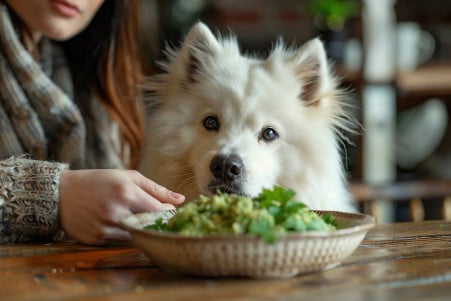Can Dogs Eat Mustard? Mustard Toxicity in Dogs
15 March 2024 • Updated 13 March 2024

Dog owners often find themselves questioning the safety of various human foods, but can dogs eat mustard? Due to the presence of toxic compounds like isothiocyanates in mustard seeds, mustard is toxic to dogs and can lead to severe gastroenteritis. Symptoms of mustard poisoning in dogs include vomiting and diarrhea. To keep your dog healthy, it’s best to avoid giving your dog mustard in any form.
This article will review veterinary literature and nutritional science to shed light on why mustard is bad for dogs. We’ll also discuss the physiological impact of the toxic compounds in mustard and how they affect dogs. Finally, we’ll discuss dog nutrition and dietary needs to give a complete picture of the risks of giving dogs mustard.
Can dogs eat mustard?
What Makes Mustard Bad for Dogs?
The Dodo explains that isothiocyanates, the compounds found in mustard seeds, are toxic to dogs. These compounds cause gastroenteritis, which is an irritation of the stomach and intestines. The painful symptoms, including vomiting, diarrhea, and stomach upset, will usually start to show up within 30 to 45 minutes of eating the mustard.
If your dog has eaten mustard, it’s important to keep an eye on them right away. Maven recommends that pet parents look for signs of a reaction to even a small amount of mustard and call their vet for advice.
If a larger amount of mustard has been consumed, the dog may need to be taken to the vet for immediate treatment, which could include having their stomach pumped or supportive care like fluids and medications to help with vomiting and diarrhea.
Not all dogs will react to isothiocyanates in the same way, and the sensitivity to the compounds can range. Smaller dogs are generally more sensitive to smaller amounts of the compounds. Rover.com warns that even a small lick of mustard off a plate can be a problem and stresses the importance of keeping mustard out of your dog’s reach to keep them safe.
The Chemicals Responsible for Mustard Toxicity: Isothiocyanates
Isothiocyanates, the main toxic components in mustard seeds, are known to be particularly harmful to dogs. These chemicals are also responsible for the pungent flavor and odor of mustard and are found in other plants like horseradish and wasabi. In mustard seeds, isothiocyanates are produced from glucosinolates, which are harmless when they are intact. However, when glucosinolates are damaged or chewed, they are converted to isothiocyanates by the enzyme myrosinase.
The toxicology of mustard seeds, as described in a paper from PMC, shows that isothiocyanates are a classic example of a double-edged sword. While they have been shown to have potential health benefits for humans, their metabolites can be toxic to both humans and animals, leading to issues like gastroenteritis. In dogs, the consumption of isothiocyanates can lead to gastrointestinal upset, which can include vomiting and diarrhea.
Meanwhile, mustard seed oil, which is used in some Asian cooking, has also been controversial due to its biologically active components, including erucic acid. While these components aren’t directly related to isothiocyanates, they further illustrate the complicated nature of mustard’s components and the potential dangers they pose.
The toxicological impact of isothiocyanates on dogs makes it clear that mustard should be avoided as a food for this pet. While more research is needed to fully understand these impacts, it’s evident that the chemicals that give mustard its unique taste are not appropriate and may even be harmful for dogs.
Glucosinolates and Animal Health
Glucosinolates are a class of compounds found in the Brassicaceae family of plants that act as precursors to isothiocyanates, which are released by plants as a defense mechanism in response to damage or consumption. While glucosinolates have been shown to have health benefits in humans, their impact on animals is less clear and may even be negative.
A paper published on PubMed by R. Mawson describes the antinutritional effects of glucosinolates, especially on animal reproduction, which can be caused by the interference of glucosinolates with iodine uptake, resulting in thyroid dysfunction.
Meanwhile, another study available on PubMed by N. Takahashi describes the toxic effects of certain isothiocyanates, including benzyl and allyl isothiocyanates, on the urinary bladders of rats, and even suggests that they may be carcinogenic. This demonstrates the fine line between the positive and negative effects of these compounds.
In the case of dogs, the research suggests that while some glucosinolates may be beneficial, their isothiocyanate derivatives can be harmful. As a result, it’s important to understand the broader implications of glucosinolates and their conversion to isothiocyanates in order to determine the potential risks they may pose to canine health, especially when it comes to feeding dogs foods like mustard.
Other Common Food Hazards for Dogs: From Chocolate to Mustard
In addition to mustard, several other common food hazards for dogs can lead to symptoms similar to those caused by mustard’s toxicity, which is due to isothiocyanates.
Chocolate contains methylxanthines, including theobromine and caffeine, which can cause symptoms that range from restlessness and vomiting to severe cardiac effects and seizures.
Grapes and their dried products, such as raisins, have been associated with acute renal failure in dogs, although the toxic substance is unknown; symptoms include vomiting and lethargy. Evidence suggests that other foods, including macadamia nuts, can cause weakness and hyperthermia in dogs, although the toxic principle has yet to be identified.
Public awareness is key to preventing these poisonings. A paper in the Journal of Medical Toxicology notes that accidental ingestions are often the result of a lack of awareness about the dangers these foods pose to dogs. Knowing the clinical signs and providing treatments like induced vomiting or supportive care can be life-saving for dogs.
Case reports and survey findings about pet food-induced poisonings underscore the wide range of sensitivities dogs have to different toxins and the importance of seeking immediate veterinary care.
It’s important to educate pet owners about these food hazards and to ensure that dogs are fed a nutritionally complete diet that doesn’t include any toxic human foods, which will help ensure their health and well-being.
How to Make Sure Your Dog Eats a Balanced Diet
According to the Clinical Nutrition Service at Cummings School, a balanced diet for dogs should include a variety of essential nutrients, such as proteins, fats, vitamins, and minerals. Each of these nutrients is important for different aspects of a dog’s health; for example, proteins are needed for muscle maintenance, while fats help to control inflammation and maintain skin and coat health.
Not following these nutritional guidelines can lead to health problems for dogs. For example, foods like mustard, which contains compounds like isothiocyanates that are potentially toxic to dogs, aren’t nutritionally complete and balanced and can be dangerous. Not only does mustard not contain the nutrients dogs need, but its isothiocyanates can lead to gastroenteritis and other problems.
To make sure your dog’s diet meets the standards for complete and balanced nutrition from the American Association of Feed Control Officials that are listed on commercial dog food products, and to make sure that it’s safe for your dog, the American College of Veterinary Nutrition recommends that you work with a veterinarian or a pet nutritionist to get personalized advice.
This will help ensure that your dog’s diet doesn’t include any human foods that are dangerous for dogs and that it meets your dog’s specific health needs.
Final Thoughts on Dogs and Mustard
In summary, mustard contains isothiocyanates, which have been shown to be toxic to dogs, leading to symptoms like vomiting and diarrhea. This article has covered the many dangers of giving mustard to dogs and stressed the importance of only feeding them foods that are safe and nutritionally sound.
Dog owners need to be careful about what they feed their pets, as many things that are safe and even healthy for people can be dangerous for dogs. Understanding dog nutrition and food safety is important in order to avoid accidental poisoning and to keep our pets healthy and happy.
As with mustard, there are many other human foods that are dangerous for dogs. By learning about these foods and using common sense when feeding our pets, we can make sure they are safe and well. This information should also help us remember to always put our pets’ safety first when it comes to their diet.


